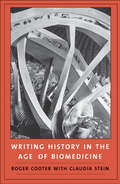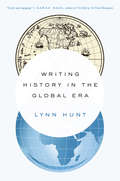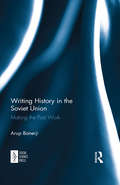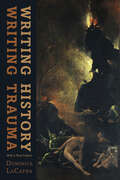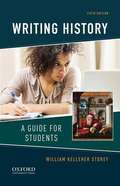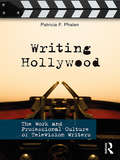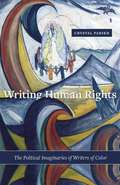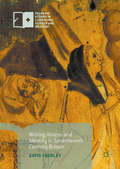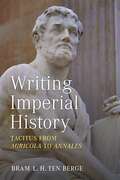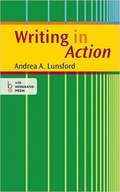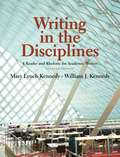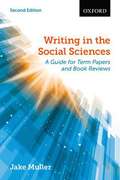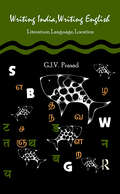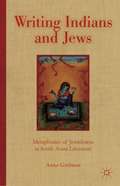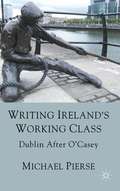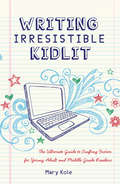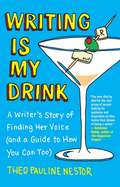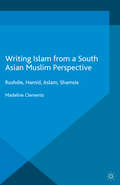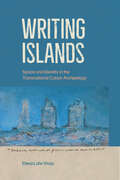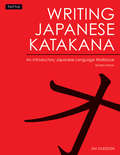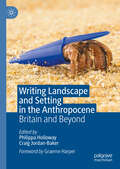- Table View
- List View
Writing History in the Age of Biomedicine
by Roger Cooter Claudia SteinA collection of ten essays paired with substantial prefaces, this book chronicles and contextualizes Roger Cooter's contributions to the history of medicine. Through an analysis of his own work, Cooter critically examines the politics of conceptual and methodological shifts in historiography. In particular, he examines the "double bind" of postmodernism and biological or neurological modeling that, together, threaten academic history. To counteract this trend, suggests Cooter, historians must begin actively locating themselves in the problems they consider.The essays and commentaries constitute a kind of contour map of history's recent trends and trajectories--its points of passage to the present--and lead both to a critical account of the discipline's historiography and to an examination of the role of intellectual frameworks and epistemic virtues in the writing of history.
Writing History in the Global Era
by Lynn HuntLeading historian Lynn Hunt rethinks why history matters in today's global world and how it should be written. George Orwell wrote that "history is written by the winners." Even if that seems a bit too cut-and-dried, we can say that history is always written from a viewpoint but that viewpoints change, sometimes radically. The history of workers, women, and minorities challenged the once-unquestioned dominance of the tales of great leaders and military victories. Then, cultural studies--including feminism and queer studies--brought fresh perspectives, but those too have run their course. With globalization emerging as a major economic, cultural, and political force, Lynn Hunt examines whether it can reinvigorate the telling of history. She hopes that scholars from East and West can collaborate in new ways and write wider-ranging works. At the same time, Hunt argues that we could better understand the effects of globalization in the past if we knew more about how individuals felt about the changes they were experiencing. She proposes a sweeping reevaluation of individuals' active role and their place in society as the keys to understanding the way people and ideas interact. She also reveals how surprising new perspectives on society and the self--from environmental history, the history of human-animal interactions, and even neuroscience--offer promising new ways of thinking about the meaning and purpose of history in our time.
Writing History in the Soviet Union: Making the Past Work
by Arup BanerjiThe history of the Soviet Union has been charted in several studies over the decades. These depictions while combining accuracy, elegance, readability and imaginativeness, have failed to draw attention to the political and academic environment within which these histories were composed. Writing History in the Soviet Union: Making the Past Work is aimed at understanding this environment. The book seeks to identify the significant hallmarks of the production of Soviet history by Soviet as well as Western historians. It traces how the Russian Revolution of 1917 triggered a shift in official policy towards historians and the publication of history textbooks for schools. In 1985, the Soviet past was again summoned for polemical revision as part and parcel of an attitude of openness (glasnost') and in this, literary figures joined their energies to those of historians. The Communist regime sought to equate the history of the country with that of the Communist Party itself in 1938 and 1962 and this imposed a blanket of conformity on history writing in the Soviet Union. The book also surveys the rich abundance of writing the Russian Revolution generated as well as the divergent approaches to the history of the period. The conditions for research in Soviet archives are described as an aspect of official monitoring of history writing. Another instance of this is the manner by which history textbooks have, through the years, been withdrawn from schools and others officially nursed into circulation. This intervention, occasioned in the present circumstance by statements by President Putin himself, in the manner in which history is taught in Russian schools, continues to this day. In other words, over the years, the regime has always worked to make the past work. Please note: Taylor & Francis does not sell or distribute the Hardback in India, Pakistan, Nepal, Bhutan, Bangladesh & Sri Lanka
Writing History, Writing Trauma (Parallax: Re-visions of Culture and Society)
by Dominick LaCapraAn updated edition of a major work in trauma studies.Trauma and its aftermath pose acute problems for historical representation and understanding. In Writing History, Writing Trauma, Dominick LaCapra critically analyzes attempts by theorists and literary critics to come to terms with trauma and with the crucial role post-traumatic testimonies—notably Holocaust testimonies—assume in thought and in writing. These attempts are addressed in a series of six interlocking essays that adapt psychoanalytic concepts to historical analysis, while employing sociocultural and political critique to elucidate trauma and its aftereffects in culture and in people. This updated edition includes a substantive new preface that reconsiders some of the issues raised in the book.
Writing History: A Guide for Students (Fifth Edition)
by William Kelleher StoreyBringing together practical methods from both history and composition, Writing History: A Guide for Students, Fifth Edition, provides a wealth of tips and advice to help students research and write essays for history classes. Now with a lay-flat binding that further increases the book's utility, Writing History covers all aspects of writing about history, including finding and researching topics, interpreting source materials, drawing inferences from sources, and constructing arguments. It concludes with three chapters that discuss writing effective sentences, using precise wording, and revising. Using numerous examples from the works of cultural, political, and social historians, Writing History serves as an ideal text for any history course that asks students to conduct research.
Writing Hollywood: The Work and Professional Culture of Television Writers
by Patricia F. PhalenWriting Hollywood highlights the writing process in the production of television drama and comedy series in the U.S. The way writers do their jobs is heavily dependent not only on the demands of commercial business, but also on the uncertainties inherent in a writing career in Hollywood. Drawing on literature in the fields of Media Industry Studies and Occupational Culture, Writing Hollywood explains writers’ efforts to control risk and survive in a constantly changing environment. Using data from personal interviews and a six-week participant observation at a prime time drama, Dr. Phalen analyzes the relationships among writers in series television, describes the interactions between writers and studio/network executives, and explains how endogenous and exogenous pressures affect the occupational culture of the television writing profession.
Writing Human Factors Research Papers: A Guidebook
by Don HarrisWriting high-quality papers suitable for publication within international scientific journals is now an essential skill for all early-career researchers; their career progression and the reputation of the department in which they work depends upon it. However, many manuscripts are rejected or sent back for major re-working not because the science they contain is in any way 'bad', but because the same problems keep occurring in the way that the material is presented. It is one thing to write a good scientific paper, however it is quite another thing to get it published. This requires some additional nous. In writing this book Don Harris draws upon nearly a quarter of a century of experience as an author and reviewer of research papers, and ultimately as a journal editor. By his own admission, it contains all the things he wished that his mentors had told him 25 years ago, but didn't. The material in the book is drawn from many years of finding all these things out for himself, usually by trial and error (but mostly error!). The text adopts a much lighter touch than is normally found in books of this type - after all, who really wants to read a book about writing research papers? The author describes his own unique approach to writing journal papers (which, in his own words, has proved to be extremely successful). All major points are illustrated with examples from his own, published works. The book is written in the form of a manual for constructing a journal manuscript: read a chapter, write a section. However, the material it contains goes beyond just this and also describes how to select a target journal, the manuscript submission process, what referees are looking for in a good journal paper, and how to deal with the referees' comments. Each chapter concludes with a checklist to ensure all the key elements have been addressed.
Writing Human Rights: The Political Imaginaries of Writers of Color
by Crystal ParikhThe legal texts and aspirational ideals of human rights are usually understood and applied in a global context with little bearing on the legal discourse, domestic political struggles, or social justice concerns within the United States. In Writing Human Rights, Crystal Parikh uses the international human rights regime to read works by contemporary American writers of color—Toni Morrison, Chang-rae Lee, Ana Castillo, Aimee Phan, and others—to explore the conditions under which new norms, more capacious formulations of rights, and alternative kinds of political communities emerge.Parikh contends that unlike humanitarianism, which views its objects as victims, human rights provide avenues for the creation of political subjects. Pairing the ethical deliberations in such works as Beloved and A Gesture Life with human rights texts like the United Nations Convention Against Torture, she considers why principles articulated as rights in international conventions and treaties—such as the right to self-determination or the right to family—are too often disregarded at home. Human rights concepts instead provide writers of color with a deeply meaningful method for political and moral imagining in their literature.Affiliating transnational works of American literature with decolonization, socialist, and other political struggles in the global south, this book illuminates a human rights critique of idealized American rights and freedoms that have been globalized in the twenty-first century. In the absence of domestic human rights enforcement, these literatures provide a considerable repository for those ways of life and subjects of rights made otherwise impossible in the present antidemocratic moment.
Writing Illness and Identity in Seventeenth-Century Britain
by David ThorleyThis book is a survey of personal illness as described in various forms of early modern manuscript life-writing. How did people in the seventeenth century rationalise and record illness? Observing that medical explanations for illness were fewer than may be imagined, the author explores the social and religious frameworks by which illness was more commonly recorded and understood. The story that emerges is of illness written into personal manuscripts in prescriptive rather than original terms. This study uncovers the ways in which illness, so described, contributed to the self-patterning these texts were set up to perform.
Writing Illness and Identity in Seventeenth-Century Britain (Palgrave Studies in Literature, Science and Medicine)
by David ThorleyThis book is a survey of personal illness as described in various forms of early modern manuscript life-writing. How did people in the seventeenth century rationalise and record illness? Observing that medical explanations for illness were fewer than may be imagined, the author explores the social and religious frameworks by which illness was more commonly recorded and understood. The story that emerges is of illness written into personal manuscripts in prescriptive rather than original terms. This study uncovers the ways in which illness, so described, contributed to the self-patterning these texts were set up to perform.
Writing Imperial History: Tacitus from Agricola to Annales
by Bram ten BergeThe late first- and early second-century Roman senator and historian Cornelius Tacitus, whom Edward Gibbon described as “the first of the historians who applied the science of philosophy to the study of facts,” shaped the development of the modern understanding of history as a crucial vehicle for social analysis. The breadth of his thinking is fully revealed only through analysis of how the political, geographical, and rhetorical theories expounded in his early works influenced his later narrative of the evolution of the Roman monarchy. Tacitus, who was one of the oratorical luminaries of his time, produced a collection of works widely recognized as offering the most authoritative account of Rome’s early imperial history. His oeuvre traditionally is divided into the so-called minor and major works. Writing Imperial History offers the first comprehensive analysis of Tacitus’ five texts and their interconnections and serves to confront longstanding assumptions that have led to a fundamental misunderstanding of the nature and development of his oeuvre and historical thinking. Tracing many of the enduring themes and concerns that Tacitus explores across his works, the book shows how the vision articulated in his earlier texts persists in his later ones and how he used the former as sources for the latter.
Writing In Action
by Andrea A. LunsfordAndrea Lunsford’s research treats student writers as writers first—not only in the classroom, but in every aspect of their lives. Her newest handbook features a simple and inviting design that helps students find solutions for every situation as they translate their skills as writers in their day-to-day lives to the conventions of solid academic writing. Featuring the writing process coverage of larger handbooks at a value price, Writing in Action is a supportive reference that emphasizes rhetorical strategies that help students put their ideas into action.
Writing In The Disciplines: A Reader And Rhetoric For Academic Writers
by William J. Kennedy Mary Lynch KennedyThis rhetoric/anthology instructs college students in how to read academic texts with understanding and how to use them as sources for papers in a variety of disciplines. <P><P>In Writing in the Disciplines, Mary Kennedy and William Kennedy emphasize academic writing as ongoing conversations in multiple genres, and do so in the context of WPA Outcomes. <P><P>The rhetoric chapters teach critical reading, paraphrasing, summarizing, quoting, writing process, synthesizing, analyzing, researching, and developing arguments. <P><P>The anthology balances journal articles with works by public intellectuals in the sciences, social sciences, and humanities.
Writing In The Social Sciences: A Guide For Term Papers And Book Reviews
by Jake MullerIdeal for students new to academic writing, Writing in the Social Sciences, Second Edition, is a clear, step-by-step guide to the entire writing process. Students will learn how to select and research a topic, develop and refine their ideas into a comprehensive outline, and convert the outline into a research paper or book report.
Writing India, Writing English: Literature, Language, Location
by G. J. PrasadThe essays in this book look at the interaction between English and other Indian languages and focus on the pressure of languages on writers and on each other. Divided into two parts, the first part of the book deals with the pressure that English language has exerted, and continues to exert, in India and our ideas of connectedness as a nation in the ways in which we deal with this pressure. The essays emphasise on the emergence of the hybrid language in the Tamil cultural world because of the presence of English (and Hindi); on the politics of ‘anthologisation’; and how Karnad’s Tughlaq deals with the idea of the nation, looking at its historical location. The second part of the book focuses on Indian English literature and deals with how it interacts with the idea of representing the Indian nation, sometimes obsessively, seen both in poetry and novels. The book argues that the writer’s location is crucial to the world of imagination, whether in the novel, poetry or drama. The world is inflected by the location of the author, and the struggle between the language dominant in that location and English is part of the creative tension that provides energy and uniqueness to writing.
Writing Indians and Jews
by Anna GuttmanWriting Indians and Jews examines discursive practices surrounding the representation of Jews and Jewishness in Indian literature in English. These investigations make an important contribution to the study of contemporary South Asian and diasporic literature, and understandings of anti-Semitism, religious fundamentalism, and globalization.
Writing Ireland’s Working Class
by Michael PierseExploring writing of working-class Dublin after Se#65533;n O'Casey, this book breaks new ground in Irish Studies, unearthing submerged narratives of class in Irish life. Examining how working-class identity is depicted by authors like Brendan Behan and Roddy Doyle, it discusses how this hidden, urban Ireland has appeared in the country's literature.
Writing Irresistible Kidlit: The Ultimate Guide to Crafting Fiction for Young Adult and Middle Grade Readers
by Mary KoleCaptivate the hearts and minds of young adult readers! Writing for young adult (YA) and middle grade (MG) audiences isn't just "kid's stuff" anymore--it's kidlit! The YA and MG book markets are healthier and more robust than ever, and that means the competition is fiercer, too. In Writing Irresistible Kidlit, literary agent Mary Kole shares her expertise on writing novels for young adult and middle grade readers and teaches you how to: Recognize the differences between middle grade and young adult audiences and how it impacts your writing. Tailor your manuscript's tone, length, and content to your readership. Avoid common mistakes and cliches that are prevalent in YA and MG fiction, in respect to characters, story ideas, plot structure and more. Develop themes and ideas in your novel that will strike emotional chords. Mary Kole's candid commentary and insightful observations, as well as a collection of book excerpts and personal insights from bestselling authors and editors who specialize in the children's book market, are invaluable tools for your kidlit career. If you want the skills, techniques, and know-how you need to craft memorable stories for teens and tweens, Writing Irresistible Kidlit can give them to you.
Writing Is My Drink
by Theo Pauline NestorWhether you're aiming for a New York Times bestseller or a short personal essay to share with family and friends, a popular blogger and memoirist shows you the way in this witty writing guide and disarmingly candid account of discovering her own voice."Theo Pauline Nestor has a big heart and a real feel for the pain and craziness of human life," wrote Pulitzer Prize-winning author Frank McCourt. This couldn't be truer in Writing Is My Drink, part memoir, part inspirational writing guide that tells the absorbing, poignant, and at times hilarious story of how Nestor found her voice as a writer. Nestor pulls no punches as she tells the stories of her life, from the darkest, most intimate moments, dealing with her alcoholic parents and the deaths of her beloved stepfather and grandmother to experiencing writer's block and the thrilling moment when she first realizes she's written something of value. With sweetness, humor, and charming candor, she shows aspiring writers how to tap into their own stories and unlock their potential. In addition, in her "Try This" sections at the end of each chapter, Nestor challenges you to take risks and deeply consider why you are writing and what you want to achieve. She also discusses successes and failures from her own life to demonstrate the challenges all writers face as well as the joys that come from tackling your dreams. With her witty, compelling, and wonderfully authentic voice, Nestor is an inspiring writing guru, whose own journey is sure to captivate and inspire.
Writing Islam from a South Asian Muslim Perspective: Rushdie, Hamid, Aslam, Shamsie
by Madeline ClementsThis book explores whether the post-9/11 novels of Rushdie, Hamid, Aslam and Shamsie can be read as part of an attempt to revise modern ‘knowledge’ of the Islamic world, using globally-distributed English-language literature to reframe Muslims’ potential to connect with others. Focussing on novels including Shalimar the Clown, The Reluctant Fundamentalist, The Wasted Vigil, and Burnt Shadows, the author combines aesthetic, historical, political and spiritual considerations with analyses of the popular discourses and critical discussions surrounding the novels; and scrutinises how the writers have been appropriated as authentic spokespeople by dominant political and cultural forces. Finally, she explores how, as writers of Indian and Pakistani origin, Rushdie, Hamid, Aslam and Shamsie negotiate their identities, and the tensions of being seen to act as Muslim representatives, in relation to the complex international and geopolitical context in which they write.
Writing Islam from a South Asian Muslim Perspective: Rushdie, Hamid, Aslam, Shamsie
by Madeline ClementsThis book explores whether the post-9/11 novels of Rushdie, Hamid, Aslam and Shamsie can be read as part of an attempt to revise modern ‘knowledge’ of the Islamic world, using globally-distributed English-language literature to reframe Muslims’ potential to connect with others. Focussing on novels including Shalimar the Clown, The Reluctant Fundamentalist, The Wasted Vigil, and Burnt Shadows, the author combines aesthetic, historical, political and spiritual considerations with analyses of the popular discourses and critical discussions surrounding the novels; and scrutinises how the writers have been appropriated as authentic spokespeople by dominant political and cultural forces. Finally, she explores how, as writers of Indian and Pakistani origin, Rushdie, Hamid, Aslam and Shamsie negotiate their identities, and the tensions of being seen to act as Muslim representatives, in relation to the complex international and geopolitical context in which they write.
Writing Islands: Space and Identity in the Transnational Cuban Archipelago
by Elena Lahr-VivazHow contemporary Cuban writers build transnational communities In Writing Islands, Elena Lahr-Vivaz employs methods from archipelagic studies to analyze works of contemporary Cuban writers on the island alongside those in exile. Offering a new lens to explore the multiplicity of Cuban space and identity, she argues that these writers approach their nation as part of a larger, transnational network of islands. Introducing the term “arcubiélago” to describe the spaces created by Cuban writers, both on the ground and in print, Lahr-Vivaz illuminates how transnational communities are forged and how they function across space and time. Lahr-Vivaz considers how poets, novelists, and essayists of the 1990s and 2000s built interconnected communities of readers through blogs, state-sponsored book fairs, informal methods of book circulation, and intertextual dialogues. Book chapters offer in-depth analyses of the works of writers as different as Reina María Rodríguez, known for lyrical poetry, and Zoé Valdés, known for strident critiques of Fidel Castro. Incorporating insights from on-site interviews in Cuba, Spain, and the United States, Lahr-Vivaz analyzes how writers maintained connections materially, through the distribution of works, and metaphorically, as their texts bridge spaces separated by geopolitics. Through a decolonizing methodology that resists limiting Cuba to a distinct geographic space, Writing Islands investigates the nuances of Cuban identity, the creation of alternate spaces of identity, the potential of the Internet for artistic expression, and the transnational bonds that join far-flung communities. Publication of this work made possible by a Sustaining the Humanities through the American Rescue Plan grant from the National Endowment for the Humanities.
Writing Japanese Katakana
by Jim GleesonThis is an introductory guide and workbook to writing Japanese Katakana.Anybody who is able to master English, with its irregular spellings and idiosyncratic pronunciations, is more than equipped to master written Japanese. The hiragana and katakana syllabaries are purely phonetic characters, which function much like the letters of the English alphabet. In this respect, kana are quite different from kanji characters, which are based on Chinese ideographs and which represent ideas. The katakana syllabary is used primarily to represent borrowed words (from languages other than Chinese), although it is also used for botanical names and is sometimes used in place of hiragana or kanji for emphasis. In some ways, the use of katakana in Japanese parallels the use of italics in English.Writing practice is the most effective method of mastering written Japanese, and the large open format of this workbook is designed to invite the student to pick up a pencil and start writing. Written Japanese comprises two phonetic syllabaries, hiragana and katakana, and a set of kanji characters that are based on Chinese ideographs. This workbook has been carefully designed to facilitate the quick and easy mastery of the 46-character katakana alphabet, making it the perfect tool to begin the process of mastering written Japanese. Each character is introduced with brushed, handwritten and typed samples that enhance character recognition. Extensive space for writing allows maximum practice to facilitate memorization and to ensure proper character formation. Entertaining illustrations and amusing examples of loan-words that use katakana in Japanese writings further reinforce memorization in a fun way. Writing Katakana is tailored to the specific needs of young students of the Japanese language, but is also well suited to beginning students of any age. This workbook contains:grayed-out, trace-over characters for correct character constructionExtensive practice in writing sentences for maximum reinforcementSupplementary explanations, including a brief history of the origin of each character, to foster visual recall.
Writing Japanese Katakana
by Jim GleesonThis is an introductory guide and workbook to writing Japanese Katakana.Anybody who is able to master English, with its irregular spellings and idiosyncratic pronunciations, is more than equipped to master written Japanese. The hiragana and katakana syllabaries are purely phonetic characters, which function much like the letters of the English alphabet. In this respect, kana are quite different from kanji characters, which are based on Chinese ideographs and which represent ideas. The katakana syllabary is used primarily to represent borrowed words (from languages other than Chinese), although it is also used for botanical names and is sometimes used in place of hiragana or kanji for emphasis. In some ways, the use of katakana in Japanese parallels the use of italics in English.Writing practice is the most effective method of mastering written Japanese, and the large open format of this workbook is designed to invite the student to pick up a pencil and start writing. Written Japanese comprises two phonetic syllabaries, hiragana and katakana, and a set of kanji characters that are based on Chinese ideographs. This workbook has been carefully designed to facilitate the quick and easy mastery of the 46-character katakana alphabet, making it the perfect tool to begin the process of mastering written Japanese. Each character is introduced with brushed, handwritten and typed samples that enhance character recognition. Extensive space for writing allows maximum practice to facilitate memorization and to ensure proper character formation. Entertaining illustrations and amusing examples of loan-words that use katakana in Japanese writings further reinforce memorization in a fun way. Writing Katakana is tailored to the specific needs of young students of the Japanese language, but is also well suited to beginning students of any age. This workbook contains:grayed-out, trace-over characters for correct character constructionExtensive practice in writing sentences for maximum reinforcementSupplementary explanations, including a brief history of the origin of each character, to foster visual recall.
Writing Landscape and Setting in the Anthropocene: Britain and Beyond
by Philippa Holloway Craig Jordan-BakerThis edited collection offers an in-depth exploration of the role of landscape and place as literary ‘settings’. It examines the multifaceted relationships between authors, narrators, and characters to their locales, as well as broader considerations of the significance of the representation of landscape in a world deeply affected by human interventions. Consisting of case studies of projects that engage with these questions, as well as research examining the theoretical underpinnings of both creative practices/processes and post-textual analysis of published works, this volume is both multidisciplinary and interdisciplinary in scope. In the context of the climate crisis and a pandemic which has caused us to re-evaluate the significance of landscape and the environment, it responds to the need to engage current trends within the academy and in broader social debate about our relationship to the natural world.
